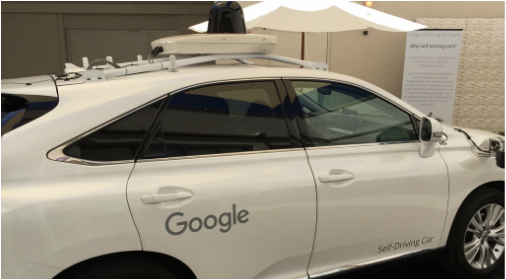
Mountain View, Austin and Chandler. These are cities where you can spot the fleet of Google self-driving cars. At a recent open house, I was surprised at how unassuming these vehicles look. They have a small sticker stating they are self-driving cars. Oh, and they have a huge black orb on top, along with a myriad of sensors.
Transportation trends are showing that Americans are starting to fall out of love with the automobile. Millennials are not getting driver’s licenses at the same rate as previous generations. Older citizens are looking for alternatives beyond driving.
Google is aware of this trend, but they are more focused on the issue of safety.
“It’s all about safety,” said Lauren Whalley, a consultant working with Google. “Look at the statistics, last year more than 35,000 people were killed in car crashes.”
The open house was a way to let the community know about their project. With 8 to 12 cars on the road, each car has sensors, lasers and cameras that provide the vehicle a 360 view. There are also test drivers in every car monitoring the system, at any time, the test driver could take control of the system.
“Chandler is a great location for our test. It is on the cutting edge of technology and it is very welcoming. Luckily, everyone has been great to work with,” said Jennifer Haroon, Head of Business Operations for Google’s Self-Driving Car.
Besides the vehicle itself, the open house also showcased videos on display about what the car sees. Haroon said a favorite of younger guests is the laser room. Unlike a camera, the lasers are able to understand what items they are facing by the shape.
Her favorite part of the exhibit is the “talk back board.
“Guests were welcomed to put down ideas on how they would use a self-driving car,” Haroon said. “Kid’s put down really fun stuff, and we hope they will be able to benefit from this technology.”
Even with more than 1.8 million miles driven autonomously, some are still weary of the new technology.
“Some people have anxiety and I am amazed is how quickly that is over come,” said Haroon. “They are amazed at all the aspects that the car sees. Then they find the ride is pretty boring, the car just drives itself. I am surprised by how quickly they start to trust the technology, within 30 seconds they are relaxed.”
So is there a day when driving will be obsolete?
“I don’t see a future where there are no drivers, driving can be a fun experience,” she said. “I equate it to an elevator, at first, we needed an individual to take us up and down buildings. As the technology advance, people got comfortable with stepping into an elevator and pushing a button.”
Learn more about Google’s self-driving project at www.google.com/selfdrivingcar/
Transportation trends are showing that Americans are starting to fall out of love with the automobile. Millennials are not getting driver’s licenses at the same rate as previous generations. Older citizens are looking for alternatives beyond driving.
Google is aware of this trend, but they are more focused on the issue of safety.
“It’s all about safety,” said Lauren Whalley, a consultant working with Google. “Look at the statistics, last year more than 35,000 people were killed in car crashes.”
The open house was a way to let the community know about their project. With 8 to 12 cars on the road, each car has sensors, lasers and cameras that provide the vehicle a 360 view. There are also test drivers in every car monitoring the system, at any time, the test driver could take control of the system.
“Chandler is a great location for our test. It is on the cutting edge of technology and it is very welcoming. Luckily, everyone has been great to work with,” said Jennifer Haroon, Head of Business Operations for Google’s Self-Driving Car.
Besides the vehicle itself, the open house also showcased videos on display about what the car sees. Haroon said a favorite of younger guests is the laser room. Unlike a camera, the lasers are able to understand what items they are facing by the shape.
Her favorite part of the exhibit is the “talk back board.
“Guests were welcomed to put down ideas on how they would use a self-driving car,” Haroon said. “Kid’s put down really fun stuff, and we hope they will be able to benefit from this technology.”
Even with more than 1.8 million miles driven autonomously, some are still weary of the new technology.
“Some people have anxiety and I am amazed is how quickly that is over come,” said Haroon. “They are amazed at all the aspects that the car sees. Then they find the ride is pretty boring, the car just drives itself. I am surprised by how quickly they start to trust the technology, within 30 seconds they are relaxed.”
So is there a day when driving will be obsolete?
“I don’t see a future where there are no drivers, driving can be a fun experience,” she said. “I equate it to an elevator, at first, we needed an individual to take us up and down buildings. As the technology advance, people got comfortable with stepping into an elevator and pushing a button.”
Learn more about Google’s self-driving project at www.google.com/selfdrivingcar/